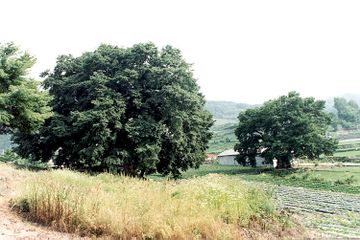"괴산 오가리 느티나무"의 두 판 사이의 차이
(→영문) |
|||
| 34번째 줄: | 34번째 줄: | ||
Saw-leaf zelkova (Zelkova serrata (Thunb.) Makino) is a deciduous broadleaf tree in the family Ulmaceae. It is usually found in the warm regions of Korea, Japan, Taiwan, and China. Its stems are upright and spread to form a round-shaped top. Its flowers bloom in April and May, and its fruits ripen in October. As this tree generally has a large trunk and thick stems, it creates a shaded area which people often used as a resting place. | Saw-leaf zelkova (Zelkova serrata (Thunb.) Makino) is a deciduous broadleaf tree in the family Ulmaceae. It is usually found in the warm regions of Korea, Japan, Taiwan, and China. Its stems are upright and spread to form a round-shaped top. Its flowers bloom in April and May, and its fruits ripen in October. As this tree generally has a large trunk and thick stems, it creates a shaded area which people often used as a resting place. | ||
| − | In Oga-ri, there are two saw-leaf zelkova trees | + | In Oga-ri, there are two saw-leaf zelkova trees: one atop the hill and the other at the foot of the hill. Their ages are presumed to be around 800 years old. They measure 29 m and 25 m in height, and 7.66 m and 9.24 m in circumference at chest level, respectively. One of the three branches of the tree at the foot of the hill was broken a long time ago, creating a hole in the trunk. |
| − | The villagers perform a ritual to the guardian spirit in front of the zelkova tree at the foot of the hill on the full moon | + | The villagers perform a ritual to the guardian spirit in front of the zelkova tree at the foot of the hill on the full moon of the first lunar month. |
| + | |||
| + | |||
| + | *정월대보름 - day라는 말 주의 | ||
===영문 해설 내용=== | ===영문 해설 내용=== | ||
2019년 10월 14일 (월) 13:05 판
| 괴산 오가리 느티나무 Saw-leaf Zelkovas of Oga-ri, Goesan |
|
 괴산 오가리 느티나무, 국가문화유산포털, 문화재청. |
|
| 대표명칭 | 괴산 오가리 느티나무 |
|---|---|
| 영문명칭 | Saw-leaf Zelkovas of Oga-ri, Goesan |
| 한자 | 槐山 五佳里 느티나무 |
| 주소 | 충청북도 괴산군 장연면 오가리 321 |
| 지정번호 | 천연기념물 제382호 |
| 지정일 | 1996년 12월 30일 |
| 분류 | 자연유산/천연기념물/문화역사기념물/민속 |
| 수량/면적 | 1주 |
| 웹사이트 | 괴산 오가리 느티나무, 국가문화유산포털, 문화재청. |
|
|
|
해설문
국문
천연기념물로 지정된 괴산 오가리 느티나무는 경사지 위쪽의 상괴목과 아래쪽의 하괴목이 있다. 나이는 약 800년 정도로 추정되며, 각각의 높이는 29m, 25m, 가슴 높이의 둘레는 7.66m, 9.24m이다.
하괴목은 3개의 중심 가지가 있는데 동쪽으로 뻗은 가지는 오래 전에 부러져 죽어 구멍이 나 있다. 상괴목은 하괴목에서 북쪽으로 60m 떨어진 지대가 높은 곳에 있고 하괴목에 비해 건강한 편이다. 이 외에도 가까운 곳에 한 그루의 느티나무가 더 있다.
이곳에는 정자는 없으나 우령마을 입구에 서 있는 세 그루의 느티나무의 모습이 마치 정자 같다고 하여 삼괴정(三槐亭)이라고 부른다. 마을 사람들은 매년 정월 대보름마다 하괴목 아래에서 서낭제를 지내고 있다.
영문
Saw-leaf Zelkovas of Oga-ri, Goesan
Saw-leaf zelkova (Zelkova serrata (Thunb.) Makino) is a deciduous broadleaf tree in the family Ulmaceae. It is usually found in the warm regions of Korea, Japan, Taiwan, and China. Its stems are upright and spread to form a round-shaped top. Its flowers bloom in April and May, and its fruits ripen in October. As this tree generally has a large trunk and thick stems, it creates a shaded area which people often used as a resting place.
In Oga-ri, there are two saw-leaf zelkova trees: one atop the hill and the other at the foot of the hill. Their ages are presumed to be around 800 years old. They measure 29 m and 25 m in height, and 7.66 m and 9.24 m in circumference at chest level, respectively. One of the three branches of the tree at the foot of the hill was broken a long time ago, creating a hole in the trunk.
The villagers perform a ritual to the guardian spirit in front of the zelkova tree at the foot of the hill on the full moon of the first lunar month.
- 정월대보름 - day라는 말 주의
영문 해설 내용
느티나무는 느릅나무과에 속하는 낙엽활엽교목이다. 한국을 비롯하여 일본, 대만, 중국 등의 따뜻한 지방에 분포한다. 가지가 사방으로 퍼져 자라서 둥근 형태로 보이며, 꽃은 4~5월에 피고 열매는 원반모양으로 10월에 익는다. 보통 크기가 크고 줄기가 굵어서 쉼터로 쓰이곤 한다.
오가리의 느티나무는 경사지 위쪽과 아래쪽에 한 그루씩 있으며, 나이는 약 800년 정도로 추정된다. 각각의 높이는 29m, 25m, 가슴 높이의 둘레는 7.66m, 9.24m이다. 아래 느티나무는 3개의 가지 중 하나가 오래전에 부러져 구멍이 나 있다.
마을 사람들은 매년 정월대보름마다 아래 느티나무 앞에서 서낭제를 지내고 있다.